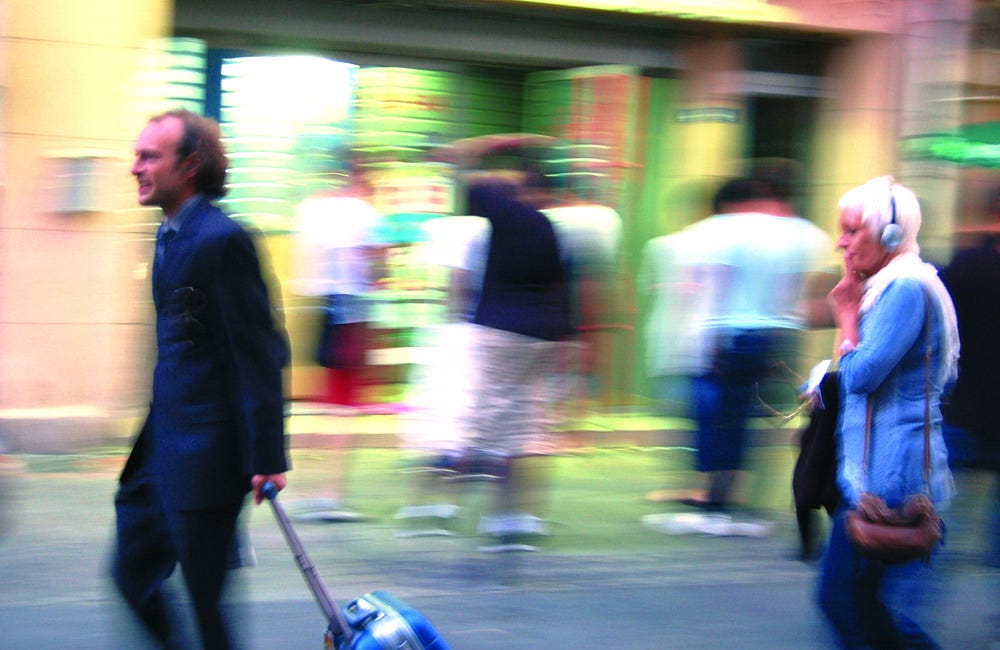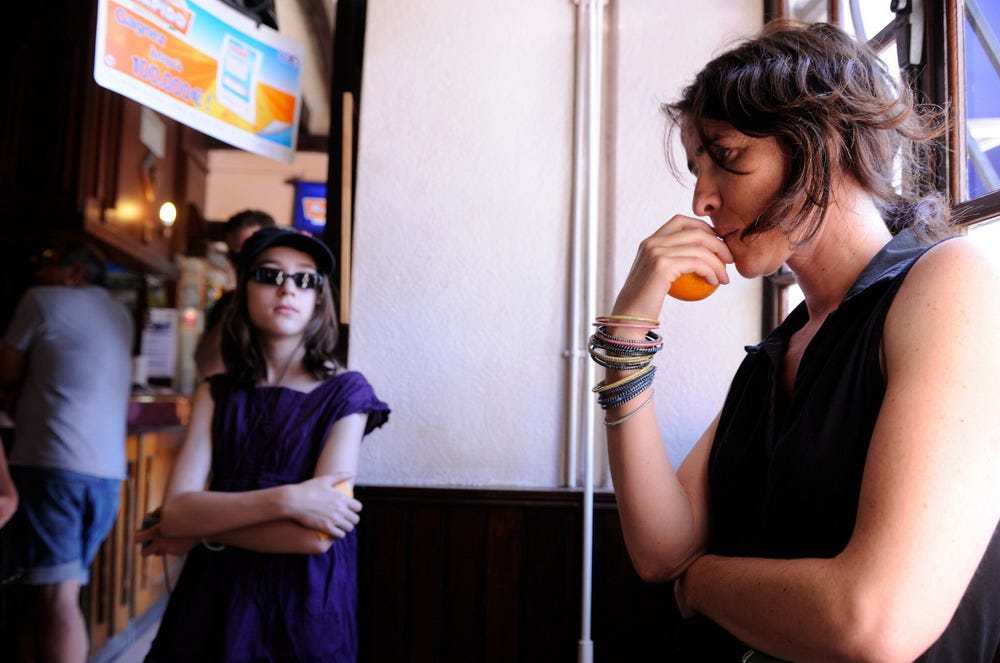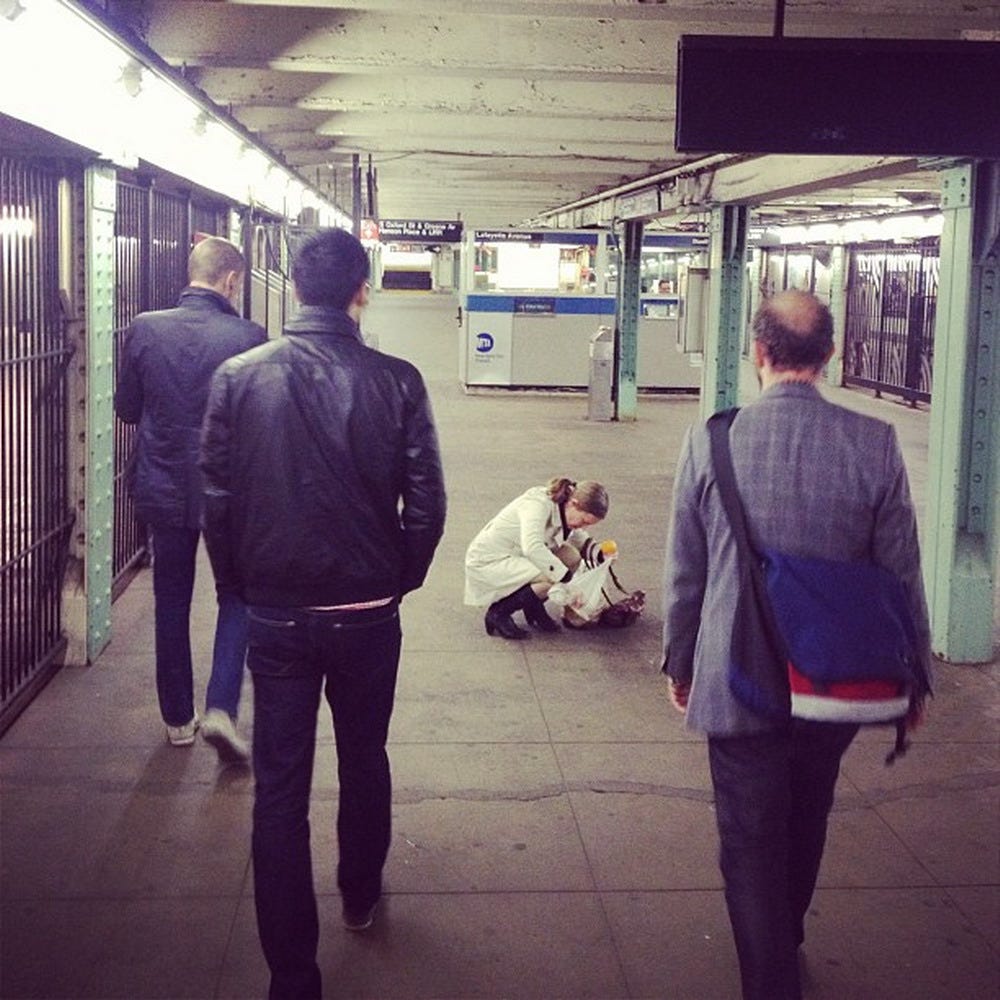‘Hidden Stories’ Reveals the Intimate Secrets of Strangers (The NoPro Review)
Begat Theater turns its audience into telepathic voyeurs on the streets of Downtown Brooklyn


New York is a walking city. When New Yorkers want to get some apples or a beer or a new hoodie, they walk. Lately I’ve been walking a lot in Downtown Brooklyn. Folks who don’t live in New York aren’t likely to end up there unless they got lost going to BAM or are passing through on their way to the Brooklyn Promenade. Like much of New York, Downtown Brooklyn is dense with people from different socioeconomic backgrounds, ethnicities, and ages: street vendors with ziplock bags of sliced up mangoes, New Yorkers from all five boroughs on their way to jury duty, hipsters heading up the Fulton Mall to Alamo Drafthouse, bleary-eyed students making their way to Brooklyn Law School, soccer moms guiding their kids toward the East River for a look at lower Manhattan. Everybody passes through Downtown Brooklyn, and maybe that’s why Begat Theater set their urban sound walk Hidden Stories on its crowded streets.
Begat Theater’s centered in France, but they were founded in New York in 1992, and they use their knowledge well in the complex choreography of this piece of invisible theatre. What does invisible theatre mean? In this case it means you may well not even notice Hidden Stories is being performed, even if you’re standing between actors and audience. Directed by Erika Latta and developed by Latta, Karin Holmström, and Dion Doulis, the play uses its invisibility to reveal the invisible worlds of our fellow pedestrians.
Following instructions from Begat Theater, I show up at a big red sculpture in front of the NYU School of Engineering during rush hour on a weekday night. Downtown Brooklyn is in full effect. A scruffy guy in a Brooklyn street sweeper’s outfit asks if I know the password. I let him know and he sends me to a secondary location, where I pick up headphones and a set of instructions.
Here the audience splits up into smaller groups, each one directed to go to a certain intersection and find a particular object. My group gets a matchbox. On the scale of Downtown Brooklyn, a matchbox is a little tiny thing, but soon I manage to pick out from the pedestrians on the sidewalk a woman carrying a red matchbox. She’s showing it off in an unnatural way, thankfully, doing her best to remain in character and wave the matchbox around at the same time. Our little group of matchbox followers tag along behind her as a voice comes up on the headphones.
That’s when the magic begins.

Through the headphones we hear the woman’s thoughts. There is a great history to stream of consciousness in literature. One might think it’s easy to recreate or approximate the flow of language inside our psyche, but it’s not. Our inner monologue isn’t liner or clean or grammatical. It follows the articulation of a dream more than it follows the logic of an essay, and recreating that flow of language requires something different than recreating believable dialogue. What comes out of the headphones feels like the real thing.
Get Zay Amsbury’s stories in your inbox
Join Medium for free to get updates from this writer.
SubscribeSubscribe
When the words that are coming from the woman’s mind begin to play on my headphones, I am taken by the courage of the language. Images and memories and observations of the mundane moment all mix together in a way that rings very true to what goes on in my own mind. It feels as if I have been placed inside the character’s mind. And it is exactly what I’ve always wanted to be able to do while walking around, observing the people of New York.
The matchbox remains difficult to follow, but the elegance of the mechanic reveals itself when the woman we’ve been following encounters another of the Hidden Stories actors. The new character is an older man, dressed up as if he might be rather down on his luck. Following the man is another group of audience members. During the course of a short, naturalistic interaction, the woman and the man exchange objects. The woman ends up with an orange. The man ends up with the matchbox. When the woman heads off down the street holding the orange, the other group follows her. My group follows the matchbox.

Through that mechanic we move through a few more characters. Each new character brings a whole new interior world. Most of the interactions between the characters are pleasant, expressed with the restrained, polite words of strangers. Whether or not you hear the dialogue between the characters depends on how close you choose to be from them. I chose to be as far away as possible. That way Downtown Brooklyn becomes a dynamic set, filled with hidden meanings of its own.
At times navigating through the streets becomes difficult. At one point a character goes to their job at a bar, and finding a place to stand so that I can both watch the character and avoid disrupting customers is distracting. At other times we are drawn down dark alleys at twilight, and it seemed as if some audience members got nervous. But overall following the characters through Downtown Brooklyn during rush hour and twilight was remarkably easy.
Begat Theater does not tell complete stories with the internal dialogues that we hear. The characters we follow are not moving through the most important days of their lives or undergoing some great transformation. What Hidden Stories offers up are vignettes of everyday life, deepened by the excellent use of stream of consciousness. What remains, as we watch the character whose inner life we have experienced, is a sense of the rich inner worlds that everyone walking around in Downtown Brooklyn carries with them.
For someone living in a walking city, that is a great gift.
Hidden Stories has concluded its run in NYC.
NoPro is a labor of love made possible by our generous Patreon backers. Join them today!
In addition to the No Proscenium web site, our podcast, and our newsletters, you can find NoPro on Twitter, Facebook, YouTube, Instagram, in the Facebook community Everything Immersive, and on our Slack forum.
Office facilities provided by Thymele Arts, in Los Angeles, CA.